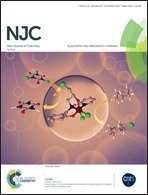Carboxylic acid functionalized multi-walled carbon nanotube assisted centri-voltammetry as a new approach for caffeine detection
Abstract
This study focuses on the applicability of centri-voltammetry by using carboxylic acid functionalized multi-walled carbon nanotubes (MWCNTs-COOH) as a carrier reagent for caffeine detection. The effects of experimental parameters such as MWCNTs-COOH amount, adsorption time, centrifugation time and speed on the caffeine peak current values were examined and the optimum working conditions were determined. The performance of the technique was evaluated and it was observed that when centri-voltammetry is applied with MWCNTs-COOH as the carrier reagent, the peak current of caffeine increases almost 281-fold compared to a direct voltammetric scan. Two linear ranges were obtained between 5–75 μM and 100–1000 μM caffeine and the limit of detection (LOD) and limit of quantification (LOQ) values were calculated to be 0.37 μM and 1.23 μM for the first range, respectively. The technique was successfully applied to the detection of caffeine in pharmaceutical formulations and the results were found to be in accordance with the values declared on the label.



 Please wait while we load your content...
Please wait while we load your content...